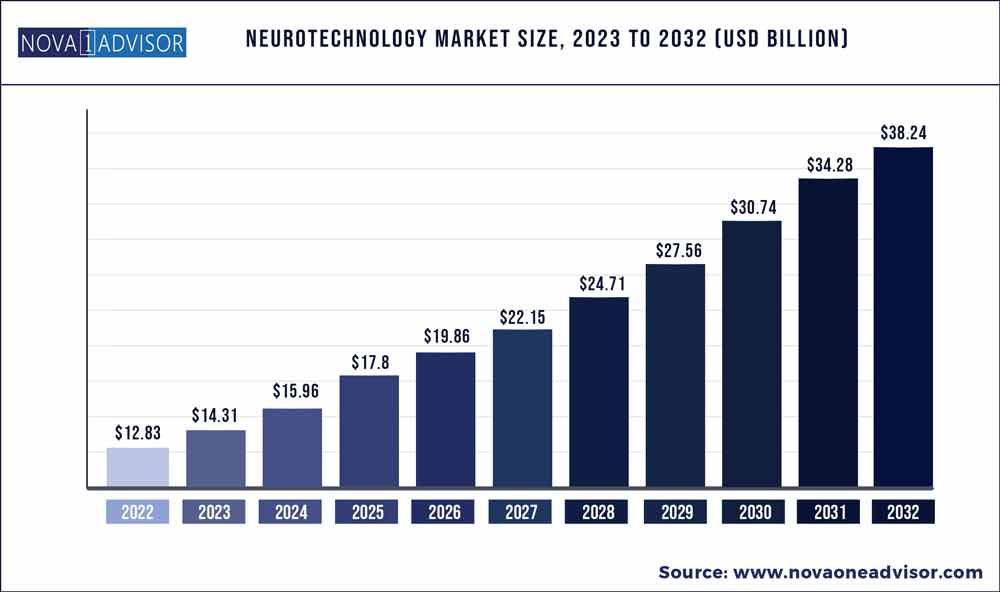The global neurotechnology market size was exhibited at USD 12.83 billion in 2022 and is projected to hit around USD 38.24 billion by 2032, growing at a CAGR of 11.54% during the forecast period 2023 to 2032.

Key Pointers:
- By product type, the neurostimulation segment will likely dominate the market in 2022.
- By conditions, the neurotech devices market share for pain treatment will likely increase significantly from 2023 to 2032.
- By end-use, the hospital segment will likely dominate the market in 2022.
- By geography, The North America is expected to expand significantly from 2023 to 2032.
Neurotechnology Market Report Scope
|
Report Coverage
|
Details
|
|
Market Size in 2023
|
USD 14.31 Billion
|
|
Market Size by 2032
|
USD 38.24 Billion
|
|
Growth Rate From 2023 to 2032
|
CAGR of 11.54%
|
|
Base Year
|
2022
|
|
Forecast Period
|
2023 to 2032
|
|
Segments Covered
|
By Product Type, By Conditions, By End-Use
|
|
Market Analysis (Terms Used)
|
Value (US$ Million/Billion) or (Volume/Units)
|
|
Regional Scope
|
North America; Europe; Asia Pacific; Central and South America; the Middle East and Africa
|
|
Key Companies Profiled
|
General Electric Company, Siemens Healthcare Private Limited, Shimadzu Corporation, Koninklijke Philips N.V., Hitachi Medical Corporation, Elekta AB, Toshiba Medical Systems Corporation, and Tristan Technologies, Inc. and Others.
|
When used fundamentally, neurotechnology has a bright future in changing human nature. The neurotechnology-based technologies that are already available describe how the brain functions, but their complete implementation necessitates more thorough research. The application of neurotechnology in medical science enables researchers to link to brain activity and comprehend people's personalities and lifestyle patterns for effective neurological illness diagnosis and prognosis. All these factors may open new growth avenues for the neurotechnology market during the forecast period of 2023-2032.
The term "neurotechnology" refers to a technological advancement that makes it possible to research or intervene in neurological processes. Nearly every component of human biology is under the direction of the nervous system, which also aids in experiencing the entire environment. An individual may be in danger from any process disruption. Therefore, neurological research and treatment are essential to both treating these people's symptoms and learning more about the intricate functions of the brain.
The expert and data-driven research report by Nova One Advisor approaches are a major contributor to our industry-leading market research accuracy. The market survey by experts produces a multi-dimensionally realistic examination of market growth parameters such as emerging trends, competitive insights, regional dynamics, drivers, restraints, and development which help the stakeholders to formulate growth strategies.
The incidence and prevalence of neurological illnesses are increasing, and this demand is being further boosted by increased funding from both public and commercial entities. Around 1 billion individuals worldwide, according to UN estimates, are affected by neurological disorders. However, the industry's expansion is likely to be hampered by expensive products, ethical issues, and a strict regulatory environment.
The sector is projected to increase significantly as a result of the rise in malignant CNS illnesses, such as Parkinsonism and Alzheimer's disease. Given that the aging population is more susceptible to illnesses of the central nervous system such as schizophrenia, Alzheimer's, and Parkinsonism, this industry is supposed to have profitable growth prospects in the years to come. The market is expected to increase as a result of a number of factors, including continuous brain mapping research and other research programs, government-led neuroscience efforts, and technological advancements in tools and algorithms used in the neuroscience field.
The prevalence and incidence of neurological illnesses are both on the rise, which is primarily responsible. Additionally, a huge patient base along with an aging population, an increase in traffic accidents, and significant government investment in research and development are the main drivers of regional expansion of the neurotechnology market.
Some of the prominent players in the Neurotechnology Market include:
- General Electric Company
- Siemens Healthcare Private Limited
- Shimadzu Corporation
- Koninklijke Philips N.V.
- Hitachi Medical Corporation
- Elekta AB
- Toshiba Medical Systems Corporation
- Tristan Technologies, Inc
Segments Covered in the Report
This report forecasts revenue growth at global, regional, and country levels and provides an analysis of the latest industry trends in each of the sub-segments from 2018 to 2032. For this study, Nova one advisor, Inc. has segmented the global Neurotechnology market.
By Product Type
- Neurostimulation
- Deep Brain Stimulator
- Spinal Cord Stimulator
- Gastric Electric Stimulator
- Vagus Nerve Stimulator
- Sacral Nerve Stimulator
- Transcutaneous Electrical Nerve Stimulation (TENS)
- Others
- Neurosensing
- Neuroprostheses
- Neurorehabilitation
By Conditions
- Cognitive Disorders
- Pain Treatment
- Urinary and Fecal Incontinence
- Epilepsy
- Parkinson's disease
- Hearing Conditions
- Sleep Disorder
- Depression
- Others
By End-Use
- Ambulatory surgical centers
- Hospitals
- Homecare facilities
- Others
By Region
- North America
- Europe
- Asia-Pacific
- Latin America
- Middle East & Africa (MEA)

